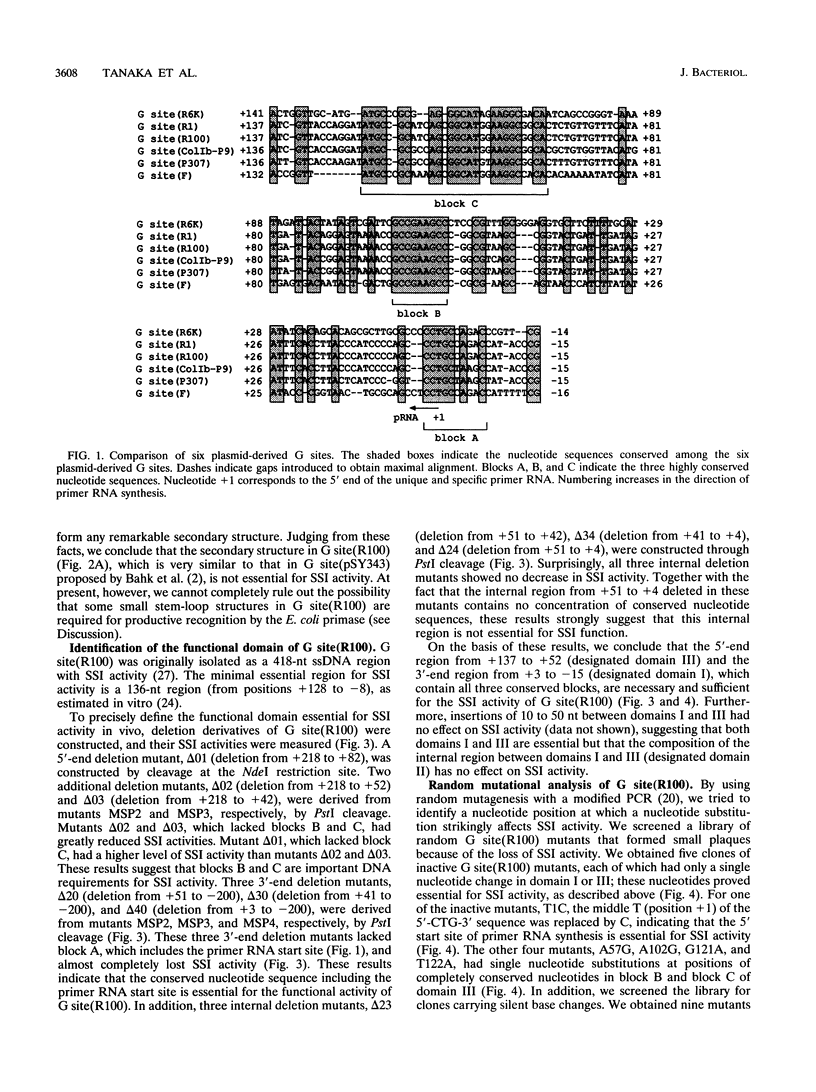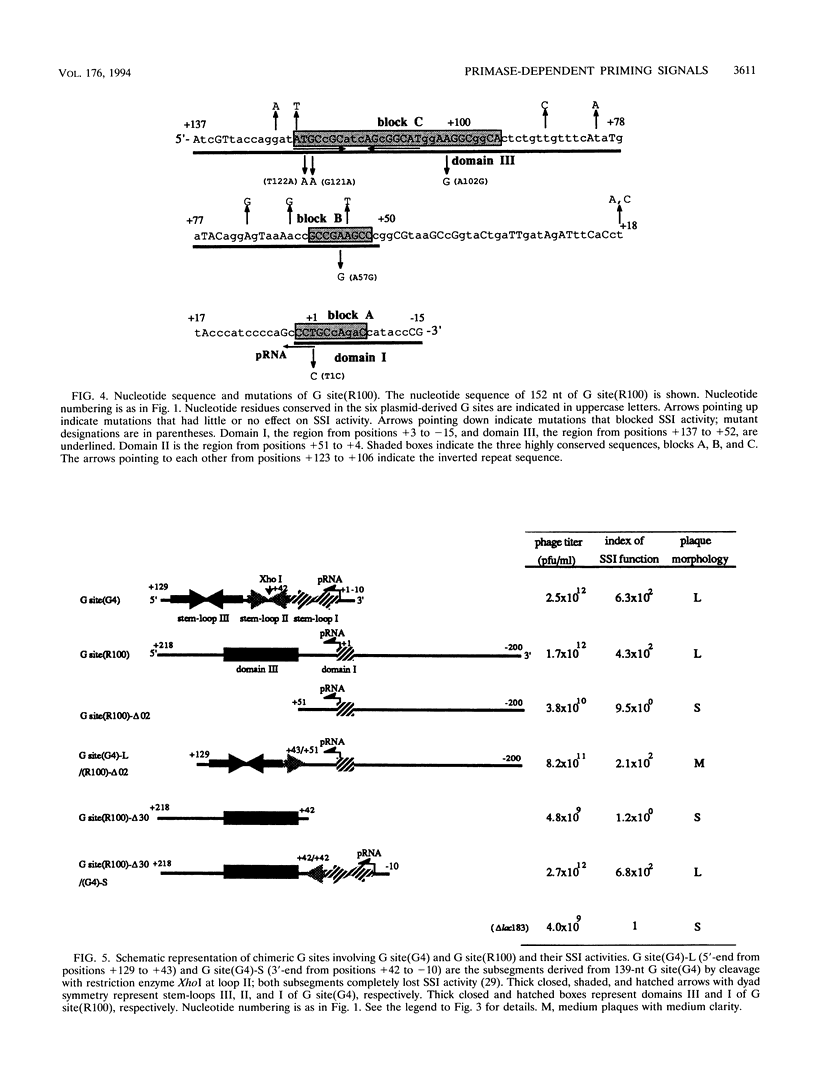Abstract
The primase-dependent priming signals, G sites, are directly recognized by the Escherichia coli primase (dnaG gene product) and conduct the synthesis of primer RNAs. In nucleotide sequence and secondary structure, there is no striking resemblance between the phage- and plasmid-derived G sites, except for the limited sequence homology near the start position of primer RNA synthesis. In this study, we analyzed the structure and function of a G site of plasmid R100, G site (R100), and discovered the necessity of the coexistence of two domains (domains I and III), which contains blocks A, B, and C, which are nucleotide sequences highly conserved among the plasmid-derived G sites. However, neither the internal region, domain II, between domains I and III nor the potential secondary structure proposed by Bahk et al. (J. D. Bahk, N. Kioka, H. Sakai, and T. Komano, Plasmid 20:266-270, 1988) is essential for single-stranded DNA initiation activity. Furthermore, chimeric G sites constructed between a G site of phage G4, G site(G4), and G site(R100) maintained significant single-stranded DNA initiation activities. These results strongly suggest that phage- and plasmid-derived G sites have functionally equivalent domains. The primase-dependent priming mechanisms of phage- and plasmid-derived G sites are discussed.
Full text
PDF







Selected References
These references are in PubMed. This may not be the complete list of references from this article.
- Arai K., Low R. L., Kornberg A. Movement and site selection for priming by the primosome in phage phi X174 DNA replication. Proc Natl Acad Sci U S A. 1981 Feb;78(2):707–711. doi: 10.1073/pnas.78.2.707. [DOI] [PMC free article] [PubMed] [Google Scholar]
- Bahk J. D., Kioka N., Sakai H., Komano T. A runaway-replication plasmid pSY343 contains two ssi signals. Plasmid. 1988 Nov;20(3):266–270. doi: 10.1016/0147-619x(88)90033-9. [DOI] [PubMed] [Google Scholar]
- Bahk J. D., Sakai H., Komano T. Plasmid pACYC184 contains an ssi signal for initiation of single-strand phage DNA replication. Gene. 1988 May 15;65(1):93–99. doi: 10.1016/0378-1119(88)90420-9. [DOI] [PubMed] [Google Scholar]
- Bernander R., Krabbe M., Nordström K. Mapping of the in vivo start site for leading strand DNA synthesis in plasmid R1. EMBO J. 1992 Dec;11(12):4481–4487. doi: 10.1002/j.1460-2075.1992.tb05549.x. [DOI] [PMC free article] [PubMed] [Google Scholar]
- Bouché J. P., Rowen L., Kornberg A. The RNA primer synthesized by primase to initiate phage G4 DNA replication. J Biol Chem. 1978 Feb 10;253(3):765–769. [PubMed] [Google Scholar]
- Chung C. T., Niemela S. L., Miller R. H. One-step preparation of competent Escherichia coli: transformation and storage of bacterial cells in the same solution. Proc Natl Acad Sci U S A. 1989 Apr;86(7):2172–2175. doi: 10.1073/pnas.86.7.2172. [DOI] [PMC free article] [PubMed] [Google Scholar]
- Geider K., Beck E., Schaller H. An RNA transcribed from DNA at the origin of phage fd single strand to replicative form conversion. Proc Natl Acad Sci U S A. 1978 Feb;75(2):645–649. doi: 10.1073/pnas.75.2.645. [DOI] [PMC free article] [PubMed] [Google Scholar]
- Glucksmann M. A., Markiewicz P., Malone C., Rothman-Denes L. B. Specific sequences and a hairpin structure in the template strand are required for N4 virion RNA polymerase promoter recognition. Cell. 1992 Aug 7;70(3):491–500. doi: 10.1016/0092-8674(92)90173-a. [DOI] [PubMed] [Google Scholar]
- Greenbaum J. H., Marians K. J. Mutational analysis of primosome assembly sites. Evidence for alternative DNA structures. J Biol Chem. 1985 Oct 5;260(22):12266–12272. [PubMed] [Google Scholar]
- Hiasa H., Sakai H., Tanaka K., Honda Y., Komano T., Godson G. N. Mutational analysis of the primer RNA template region in the replication origin (oric) of bacteriophage G4: priming signal recognition by Escherichia coli primase. Gene. 1989 Dec 7;84(1):9–16. doi: 10.1016/0378-1119(89)90133-9. [DOI] [PubMed] [Google Scholar]
- Hiasa H., Tanaka K., Sakai H., Yoshida K., Honda Y., Komano T., Godson G. N. Distinct functional contributions of three potential secondary structures in the phage G4 origin of complementary DNA strand synthesis. Gene. 1989 Dec 7;84(1):17–22. doi: 10.1016/0378-1119(89)90134-0. [DOI] [PubMed] [Google Scholar]
- Honda Y., Akioka T., Takebe S., Tanaka K., Miao D., Higashi A., Nakamura T., Taguchi Y., Sakai H., Komano T. Mutational analysis of the specific priming signal essential for DNA replication of the broad host-range plasmid RSF1010. FEBS Lett. 1993 Jun 7;324(1):67–70. doi: 10.1016/0014-5793(93)81534-7. [DOI] [PubMed] [Google Scholar]
- Honda Y., Sakai H., Komano T. Two single-strand DNA initiation signals located in the oriV region of plasmid RSF1010. Gene. 1988 Sep 7;68(2):221–228. doi: 10.1016/0378-1119(88)90024-8. [DOI] [PubMed] [Google Scholar]
- Imber R., Low R. L., Ray D. S. Identification of a primosome assembly site in the region of the ori 2 replication origin of the Escherichia coli mini-F plasmid. Proc Natl Acad Sci U S A. 1983 Dec;80(23):7132–7136. doi: 10.1073/pnas.80.23.7132. [DOI] [PMC free article] [PubMed] [Google Scholar]
- Inoue H., Nojima H., Okayama H. High efficiency transformation of Escherichia coli with plasmids. Gene. 1990 Nov 30;96(1):23–28. doi: 10.1016/0378-1119(90)90336-p. [DOI] [PubMed] [Google Scholar]
- Kubota Y., Arai K., Masai H. Roles of the G site and phi X174-type primosome assembly site in priming of leading-strand synthesis: initiation by a mobile primosome and replication-fork arrest by RepA protein bound to oriR. Gene. 1993 Apr 15;126(1):9–16. doi: 10.1016/0378-1119(93)90584-p. [DOI] [PubMed] [Google Scholar]
- Lambert P. F., Waring D. A., Wells R. D., Reznikoff W. S. DNA requirements at the bacteriophage G4 origin of complementary-strand DNA synthesis. J Virol. 1986 May;58(2):450–458. doi: 10.1128/jvi.58.2.450-458.1986. [DOI] [PMC free article] [PubMed] [Google Scholar]
- Lee M. S., Marians K. J. The Escherichia coli primosome can translocate actively in either direction along a DNA strand. J Biol Chem. 1989 Aug 25;264(24):14531–14542. [PubMed] [Google Scholar]
- Masai H., Arai K. Initiation of lagging-strand synthesis for pBR322 plasmid DNA replication in vitro is dependent on primosomal protein i encoded by dnaT. J Biol Chem. 1988 Oct 15;263(29):15016–15023. [PubMed] [Google Scholar]
- Masai H., Arai K. Leading strand synthesis of R1 plasmid replication in vitro is primed by primase alone at a specific site downstream of oriR. J Biol Chem. 1989 May 15;264(14):8082–8090. [PubMed] [Google Scholar]
- Masai H., Nomura N., Arai K. The ABC-primosome. A novel priming system employing dnaA, dnaB, dnaC, and primase on a hairpin containing a dnaA box sequence. J Biol Chem. 1990 Sep 5;265(25):15134–15144. [PubMed] [Google Scholar]
- Masai H., Nomura N., Kubota Y., Arai K. Roles of phi X174 type primosome- and G4 type primase-dependent primings in initiation of lagging and leading strand syntheses of DNA replication. J Biol Chem. 1990 Sep 5;265(25):15124–15133. [PubMed] [Google Scholar]
- Minden J. S., Marians K. J. Replication of pBR322 DNA in vitro with purified proteins. Requirement for topoisomerase I in the maintenance of template specificity. J Biol Chem. 1985 Aug 5;260(16):9316–9325. [PubMed] [Google Scholar]
- Nomura N., Low R. L., Ray D. S. Identification of ColE1 DNA sequences that direct single strand-to-double strand conversion by a phi X174 type mechanism. Proc Natl Acad Sci U S A. 1982 May;79(10):3153–3157. doi: 10.1073/pnas.79.10.3153. [DOI] [PMC free article] [PubMed] [Google Scholar]
- Nomura N., Masai H., Inuzuka M., Miyazaki C., Ohtsubo E., Itoh T., Sasamoto S., Matsui M., Ishizaki R., Arai K. Identification of eleven single-strand initiation sequences (ssi) for priming of DNA replication in the F, R6K, R100 and ColE2 plasmids. Gene. 1991 Dec 1;108(1):15–22. doi: 10.1016/0378-1119(91)90482-q. [DOI] [PubMed] [Google Scholar]
- Ray D. S., Hines J. C., Kim M. H., Imber R., Nomura N. M13 vectors for selective cloning of sequences specifying initiation of DNA synthesis on single-stranded templates. Gene. 1982 Jun;18(3):231–238. doi: 10.1016/0378-1119(82)90160-3. [DOI] [PubMed] [Google Scholar]
- Sakai H., Godson G. N. Isolation and construction of mutants of the G4 minus strand origin: analysis of their in vivo activity. Biochim Biophys Acta. 1985 Oct 3;826(1):30–37. doi: 10.1016/s0167-4781(85)80005-1. [DOI] [PubMed] [Google Scholar]
- Sakai H., Hiasa H., Iwamoto K., Horimoto T., Komano T., Godson G. N. Role of the potential secondary structures in phage G4 origin of complementary DNA strand synthesis. Gene. 1988 Nov 30;71(2):323–330. doi: 10.1016/0378-1119(88)90049-2. [DOI] [PubMed] [Google Scholar]
- Sakai H., Komano T., Godson G. N. Replication origin (oric) on the complementary DNA strand of Escherichia coli phage G4: biological properties of mutants. Gene. 1987;53(2-3):265–273. doi: 10.1016/0378-1119(87)90015-1. [DOI] [PubMed] [Google Scholar]
- Sheaff R. J., Kuchta R. D. Mechanism of calf thymus DNA primase: slow initiation, rapid polymerization, and intelligent termination. Biochemistry. 1993 Mar 30;32(12):3027–3037. doi: 10.1021/bi00063a014. [DOI] [PubMed] [Google Scholar]
- Soeller W., Abarzúa P., Marians K. J. Mutational analysis of primosome assembly sites. II. Role of secondary structure in the formation of active sites. J Biol Chem. 1984 Nov 25;259(22):14293–14300. [PubMed] [Google Scholar]
- Sun W., Godson G. N. Binding and phasing of Escherichia coli single-stranded DNA-binding protein by the secondary structure of phage G4 origin of complementary DNA strand synthesis (G4oric). J Biol Chem. 1993 Apr 15;268(11):8026–8039. [PubMed] [Google Scholar]
- Swart J. R., Griep M. A. Primase from Escherichia coli primes single-stranded templates in the absence of single-stranded DNA-binding protein or other auxiliary proteins. Template sequence requirements based on the bacteriophage G4 complementary strand origin and Okazaki fragment initiation sites. J Biol Chem. 1993 Jun 15;268(17):12970–12976. [PubMed] [Google Scholar]
- Tanaka K., Sakai H., Honda Y., Nakamura T., Higashi A., Komano T. Structural and functional features of cis-acting sequences in the basic replicon of plasmid ColIb-P9. Nucleic Acids Res. 1992 Jun 11;20(11):2705–2710. doi: 10.1093/nar/20.11.2705. [DOI] [PMC free article] [PubMed] [Google Scholar]
- Tanaka K., Sakai T., Honda Y., Hiasa H., Sakai H., Komano T. Plasmid Co1IB contains an ssi signal close to the replication origin. Plasmid. 1991 Mar;25(2):125–130. doi: 10.1016/0147-619x(91)90024-q. [DOI] [PubMed] [Google Scholar]
- Taylor J. W., Ott J., Eckstein F. The rapid generation of oligonucleotide-directed mutations at high frequency using phosphorothioate-modified DNA. Nucleic Acids Res. 1985 Dec 20;13(24):8765–8785. doi: 10.1093/nar/13.24.8765. [DOI] [PMC free article] [PubMed] [Google Scholar]
- Taylor J. W., Schmidt W., Cosstick R., Okruszek A., Eckstein F. The use of phosphorothioate-modified DNA in restriction enzyme reactions to prepare nicked DNA. Nucleic Acids Res. 1985 Dec 20;13(24):8749–8764. doi: 10.1093/nar/13.24.8749. [DOI] [PMC free article] [PubMed] [Google Scholar]
- Yanisch-Perron C., Vieira J., Messing J. Improved M13 phage cloning vectors and host strains: nucleotide sequences of the M13mp18 and pUC19 vectors. Gene. 1985;33(1):103–119. doi: 10.1016/0378-1119(85)90120-9. [DOI] [PubMed] [Google Scholar]
- Zipursky S. L., Marians K. J. Escherichia coli factor Y sites of plasmid pBR322 can function as origins of DNA replication. Proc Natl Acad Sci U S A. 1981 Oct;78(10):6111–6115. doi: 10.1073/pnas.78.10.6111. [DOI] [PMC free article] [PubMed] [Google Scholar]


